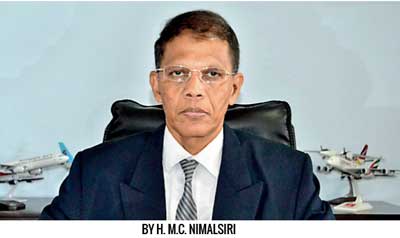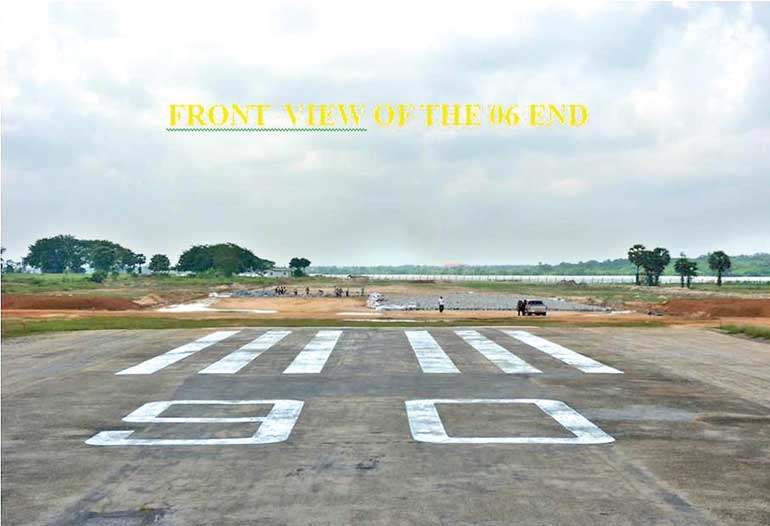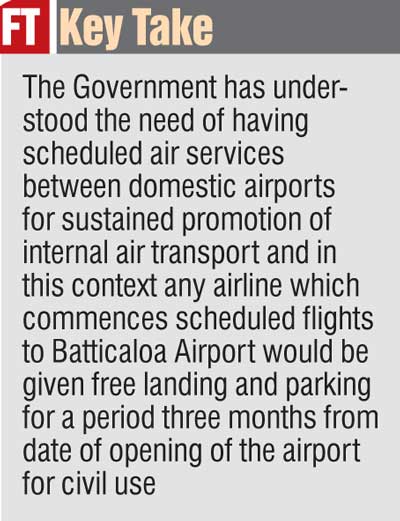Friday Apr 18, 2025
Friday Apr 18, 2025
Monday, 26 March 2018 00:00 - - {{hitsCtrl.values.hits}}
Batticaloa Airport was opened almost 60 years ago on 17 November 1958 and was administered by Department of Civil Aviation initially. Army Engineers of the Sri Lanka Army had helped to make the airport operable and it was open to all members of the public.

About 10 years after its opening, the internal scheduled flights of Air Ceylon, which had been operated between the Ratmalana and Jaffna Airports, were extended to cover Batticaloa Airport as well. Air Ceylon used to operate daily flights to Batticaloa via Gal Oya (Ampara) using Nord (French made) aircraft which had 29 seats. The flight between Ratmalana and Batticaloa took only 75 minutes and was in great demand.
Air Ceylon had introduced a mechanism for Government servants to use three annual railway warrants to take internal flights in lieu to places of their choices and many people had enjoyed that opportunity to gain rare experience of air travel. However, with the close of Air Ceylon on 31 August 1979, the operation of internal scheduled flights were ceased. On 27 March 1983 the Air Force took over the operational control of the airport and established an airbase at the site. With a proposal for expansion of the airport in around 1997, about 300 families living close to the airport were shifted and given alternate land.
The airport is located on the island of Thimilathiu in the eastern coast of Sri Lanka at a distance of 0.94 nautical miles (1.7 km) southwest of Batticaloa town at an elevation of three meters (10 ft). Batticaloa Airport had a runway oriented in the direction of 0600/2400 with a bitumen surface of a length and width of 1,066 by 46 metres (3,497 ft × 151 ft) respectively. Air distance between Katunayake and Batticaloa is only 206 km and Batticaloa and Ratmalana is 220 km.
The airport did not undergo any major rehabilitation since construction until 2012 and therefore was in a dilapidated condition which was unsafe for civil air transport operations.
With Sri Lanka’s commemoration of 100 years in aviation in 2012 and the Government’s plan to develop internal air travel, a project was launched on 3September 2012 for the renovation of Batticaloa Airport with laying of foundation stone by the President for the construction of the terminal building. The objective of development of the airport was also to help promote influx of tourists into the region by providing safer and expeditious travel instead of letting them spending long hours on roads.
The commencement of the project planned foran extension and overlay to the existing runway, fixing of runway lights and construction of a new terminal building as well as the apron; the area where aircraft are parked. As the Batticaloa runway is locked at either ends between the lagoon, it could not be extended beyond 1,560 meters, which is adequate for operation of 60-seater aircraft.

Runway expansion work was done initially by the Road Development Authority (60%) and the balance part was completed by Sri Lanka Air Force. The total budget allocated for the reconstruction of the runway, apron and terminal building which is Rs.1,400 million was borne by the General Treasury. The airport after renovation was declared open by the President on 10 July 2016. However, formal opening of the airport of civil operations were deferred as the airport had to conform to some of civil aviation requirements, which are now fulfilled.
With a view to giving the airport a civilian outlook and making it more friendly and attractive to air commuters and in accordance with the provisions made in the Civil Aviation Authority of Sri Lanka Act No. 34 of 2002, the Government took a decision to vest the Batticaloa Airport in the Civil Aviation Authority (CAA) with effect from 31 May 2016. At the same time, the Minister of Transport and Civil Aviation appointed Airport and Aviation Services (Sri Lanka) Ltd., which is identified as the Statutory Service Provider, as the Service Provider to operate the Batticaloa Airport as a civil airport.
The airport has a total land space of145.2 hectares and the portion thereof amounting to 75.9 hectares has been retained by Sri Lanka Air Force (SLAF) for continued operation of its airbase. The remaining portion of land has been cordoned off with a fence demarcating the civil and military areas clearly. The northern side of the runways is fully cleared for civil aviation operations. Separate access has been provided for civilians to enter the airport without the need of undergoing the strict security screening process that is usually performed by military when allowing a civilian to enter any military base.

Batticaloa Airport functions between sunrise to sunset daily as a fully civil airport which allows aircraft operations under visual meteorological conditions under the control and supervision of Airports and Aviation Services. SLAF will not get involved in the operation of the airport other than handing their own flights.
Air traffic control at the Batticaloa Airport is provided by trained and licensed personnel to provide air traffic control services in accordance with international standards. Commercial aircraft are allowed to perform self-handing with a view to enhancing the efficiency and bringing down the cost of air travel.
The Civil Aviation Authority of Sri Lanka has issued an Aerodrome Licence to Airport and Aviation Services in accordance with the Air Navigation Regulations of 1955 to operate the airport as a civil airport after ascertaining their compliance with the applicable international standards. Batticaloa Aerodrome Operations Manual, which has been prepared by AASL specifying all arrangements and procedures (including normal, abnormal and emergency procedures) that the airport shall conform to in the conduct of its commercial operations, has been approved by the CAASL.
The airport and its immediate environs have been declared a Protected Area by the Minister of Transport and Civil Aviation in terms of an order published in the gazette under the Civil Aviation Act and any high-rise construction within the Protected Area will have to conform to the zoning instructions issued by the Director General of Civil Aviation for preservation of effective use of airspace for safe operation of aircraft to the airport.
The Government encourages establishment of flying schools and related industries centring the airport aiming at resurrection and up-keeping of social life and conditions of living in the area. The Government has understood the need of having scheduled air services between domestic airports for sustained promotion of internal air transport and in this context any airline which commences scheduled flights to Batticaloa Airport would be given free landing and parking for a period three months from date of opening of the airport for civil use.
Currently Cinnamon Air is operating twice daily scheduled flights to Batticaloa and a few more airlines have indicated willingness to commence scheduled flights to Batticaloa Airport.
(The writer is Director General of Civil Aviation and Chief Executive Officer of the Civil Aviation Authority of Sri Lanka.)
Discover Kapruka, the leading online shopping platform in Sri Lanka, where you can conveniently send Gifts and Flowers to your loved ones for any event including Valentine ’s Day. Explore a wide range of popular Shopping Categories on Kapruka, including Toys, Groceries, Electronics, Birthday Cakes, Fruits, Chocolates, Flower Bouquets, Clothing, Watches, Lingerie, Gift Sets and Jewellery. Also if you’re interested in selling with Kapruka, Partner Central by Kapruka is the best solution to start with. Moreover, through Kapruka Global Shop, you can also enjoy the convenience of purchasing products from renowned platforms like Amazon and eBay and have them delivered to Sri Lanka.
Discover Kapruka, the leading online shopping platform in Sri Lanka, where you can conveniently send Gifts and Flowers to your loved ones for any event including Valentine ’s Day. Explore a wide range of popular Shopping Categories on Kapruka, including Toys, Groceries, Electronics, Birthday Cakes, Fruits, Chocolates, Flower Bouquets, Clothing, Watches, Lingerie, Gift Sets and Jewellery. Also if you’re interested in selling with Kapruka, Partner Central by Kapruka is the best solution to start with. Moreover, through Kapruka Global Shop, you can also enjoy the convenience of purchasing products from renowned platforms like Amazon and eBay and have them delivered to Sri Lanka.